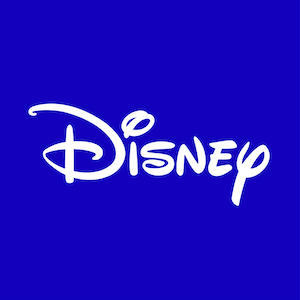
Warner Bros. Discovery (WBD)
We wouldn’t buy Warner Bros. Discovery. Its poor sales growth shows demand is soft and its negative returns on capital suggest it destroyed value.― StockStory Analyst Team
1. News
2. Summary
Why We Think Warner Bros. Discovery Will Underperform
Formed from the merger of WarnerMedia and Discovery, Warner Bros. Discovery (NASDAQ:WBD) is a multinational media and entertainment company, offering television networks, streaming services, and film and television production.
- Sales tumbled by 5.1% annually over the last two years, showing consumer trends are working against its favor
- Earnings per share fell by 32.2% annually over the last five years while its revenue grew, showing its incremental sales were much less profitable
- Forecasted revenue decline of 2.7% for the upcoming 12 months implies demand will fall even further


Warner Bros. Discovery is in the doghouse. There are more promising alternatives.
Why There Are Better Opportunities Than Warner Bros. Discovery
High Quality
Investable
Underperform
Why There Are Better Opportunities Than Warner Bros. Discovery
Warner Bros. Discovery is trading at $24.45 per share, or 7x forward EV-to-EBITDA. This sure is a cheap multiple, but you get what you pay for.
Cheap stocks can look like a great deal at first glance, but they can be value traps. They often have less earnings power, meaning there is more reliance on a re-rating to generate good returns - an unlikely scenario for low-quality companies.
3. Warner Bros. Discovery (WBD) Research Report: Q3 CY2025 Update
Global entertainment and media company Warner Bros. Discovery (NASDAQ:WBD) missed Wall Street’s revenue expectations in Q3 CY2025, with sales falling 6% year on year to $9.05 billion. Its GAAP loss of $0.06 per share was $0.03 above analysts’ consensus estimates.
Warner Bros. Discovery (WBD) Q3 CY2025 Highlights:
- Revenue: $9.05 billion vs analyst estimates of $9.22 billion (6% year-on-year decline, 1.9% miss)
- EPS (GAAP): -$0.06 vs analyst estimates of -$0.09 ($0.03 beat)
- Adjusted EBITDA: $2.47 billion vs analyst estimates of $2.19 billion (27.3% margin, 13% beat)
- Operating Margin: 6.8%, up from 2.9% in the same quarter last year
- Free Cash Flow Margin: 7.8%, up from 6.6% in the same quarter last year
- Market Capitalization: $56.35 billion
Company Overview
Formed from the merger of WarnerMedia and Discovery, Warner Bros. Discovery (NASDAQ:WBD) is a multinational media and entertainment company, offering television networks, streaming services, and film and television production.
The creation of Warner Bros. Discovery brought together WarnerMedia's extensive entertainment, sports, and news assets with Discovery's expertise in non-fiction and international entertainment. This merger was aimed to build a comprehensive media portfolio, ready to meet the changing consumption patterns and demand for diverse content across various platforms.
The company offers a wide range of entertainment options, including numerous TV networks, a collection of direct-to-consumer streaming services, and widespread film and TV production capabilities. Warner Bros. Discovery caters to the need for quality content across different genres and formats, ensuring a position in the global entertainment sector.
Warner Bros. Discovery's revenue is generated through content distribution, advertising, subscription services, and licensing. Its business model focuses on leveraging its extensive content library and global reach to deliver content to audiences worldwide.
4. Media
The advent of the internet changed how shows, films, music, and overall information flow. As a result, many media companies now face secular headwinds as attention shifts online. Some have made concerted efforts to adapt by introducing digital subscriptions, podcasts, and streaming platforms. Time will tell if their strategies succeed and which companies will emerge as the long-term winners.
Competitors in the local media and digital marketing industry include iHeartMedia (NASDAQ:IHRT), Cumulus Media (NASDAQ:CMLS), and Beasley Broadcast (NASDAQ:BBGI).
5. Revenue Growth
A company’s long-term performance is an indicator of its overall quality. Any business can put up a good quarter or two, but many enduring ones grow for years. Luckily, Warner Bros. Discovery’s sales grew at an exceptional 28.9% compounded annual growth rate over the last five years. Its growth beat the average consumer discretionary company and shows its offerings resonate with customers.
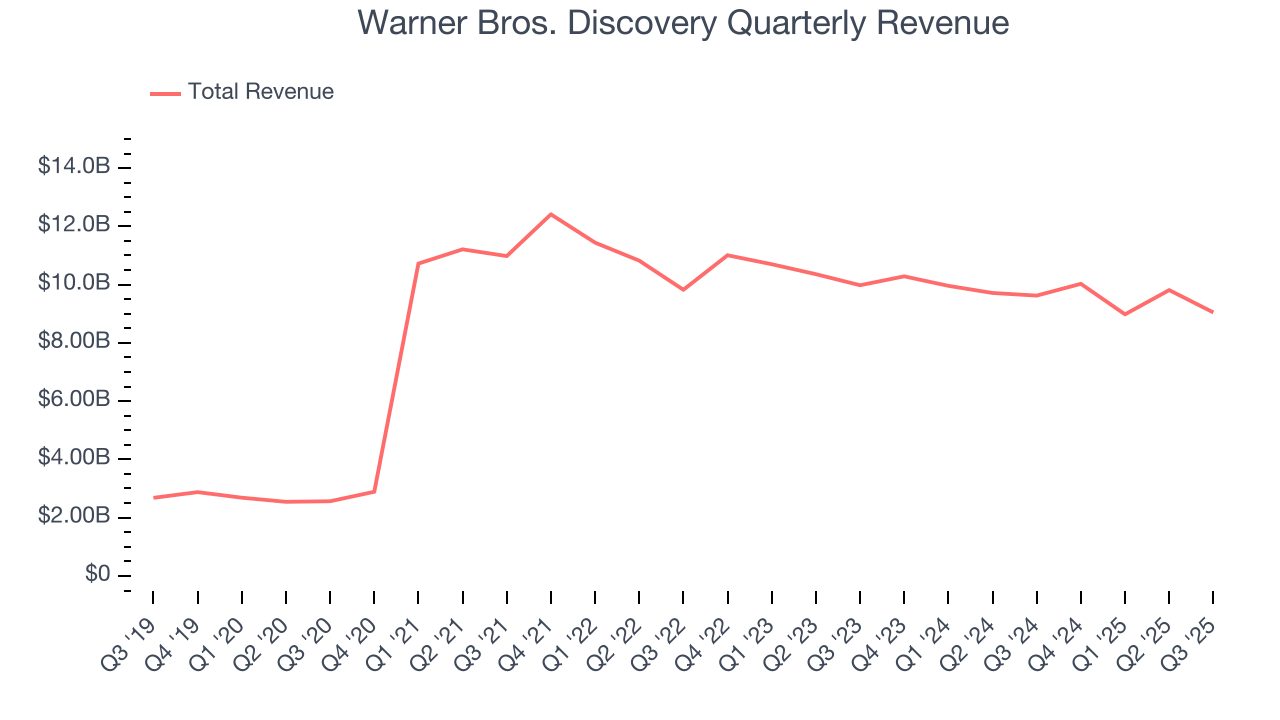
Long-term growth is the most important, but within consumer discretionary, product cycles are short and revenue can be hit-driven due to rapidly changing trends and consumer preferences. Warner Bros. Discovery’s recent performance marks a sharp pivot from its five-year trend as its revenue has shown annualized declines of 5.1% over the last two years. 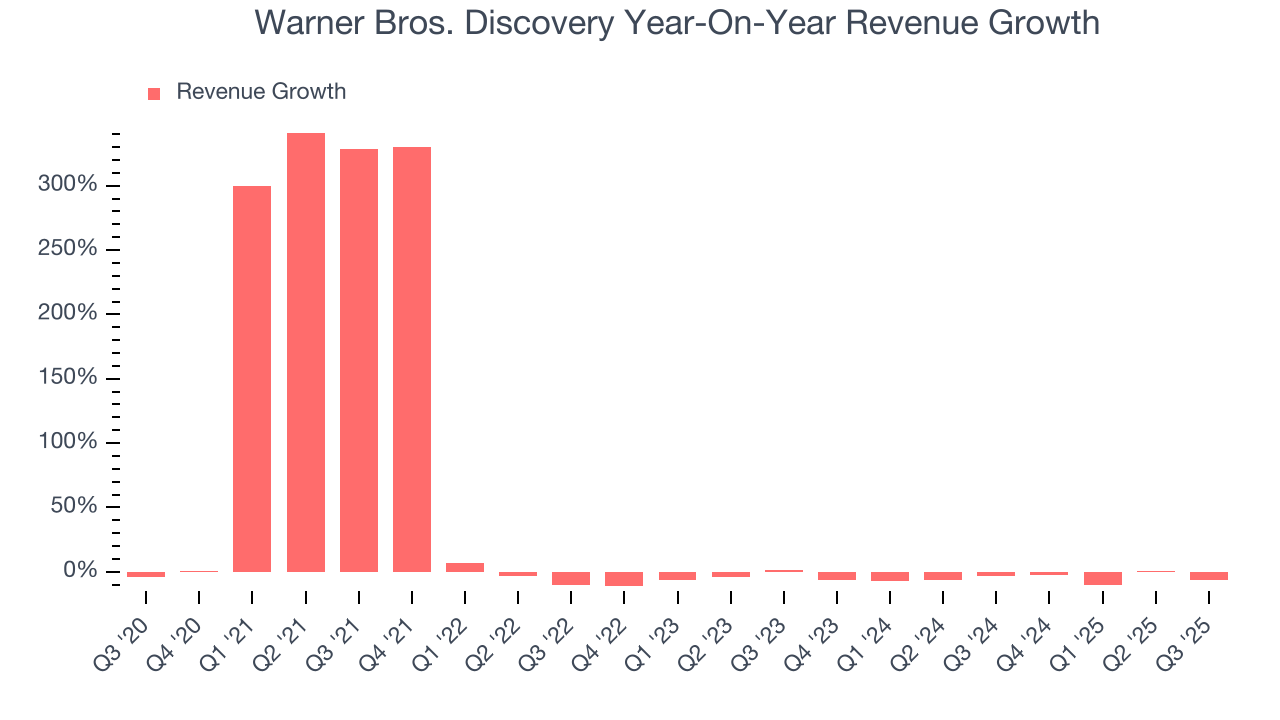
We can better understand the company’s revenue dynamics by analyzing its three most important segments: Distribution, Advertising, and Content, which are 52%, 15.6%, and 29.3% of revenue. Over the last two years, Warner Bros. Discovery’s revenues in all three segments declined. Its Distribution revenue (licensing fees) averaged year-on-year decreases of 2.2% while its Advertising (marketing services) and Content (films, streaming, games) revenues averaged drops of 8.8% and 7.5%. 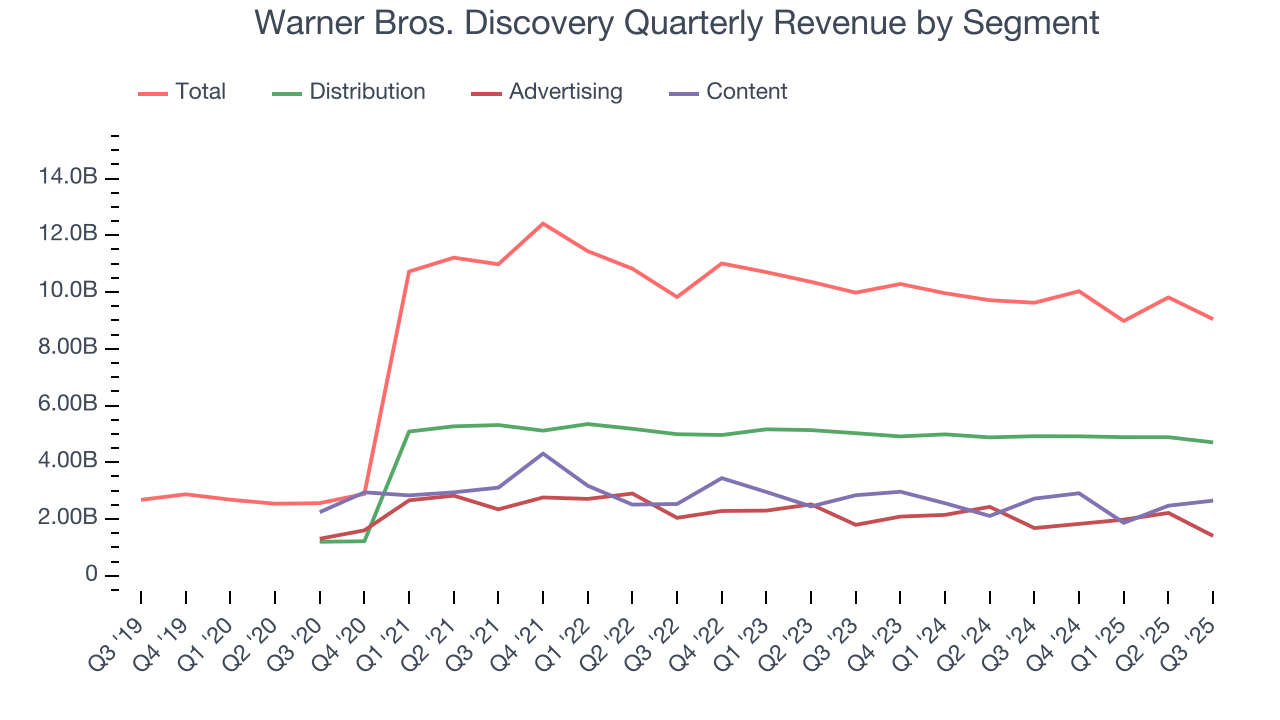
This quarter, Warner Bros. Discovery missed Wall Street’s estimates and reported a rather uninspiring 6% year-on-year revenue decline, generating $9.05 billion of revenue.
Looking ahead, sell-side analysts expect revenue to remain flat over the next 12 months. While this projection indicates its newer products and services will fuel better top-line performance, it is still below the sector average.
6. Operating Margin
Warner Bros. Discovery’s operating margin has risen over the last 12 months, but it still averaged negative 12.7% over the last two years. This is due to its large expense base and inefficient cost structure.
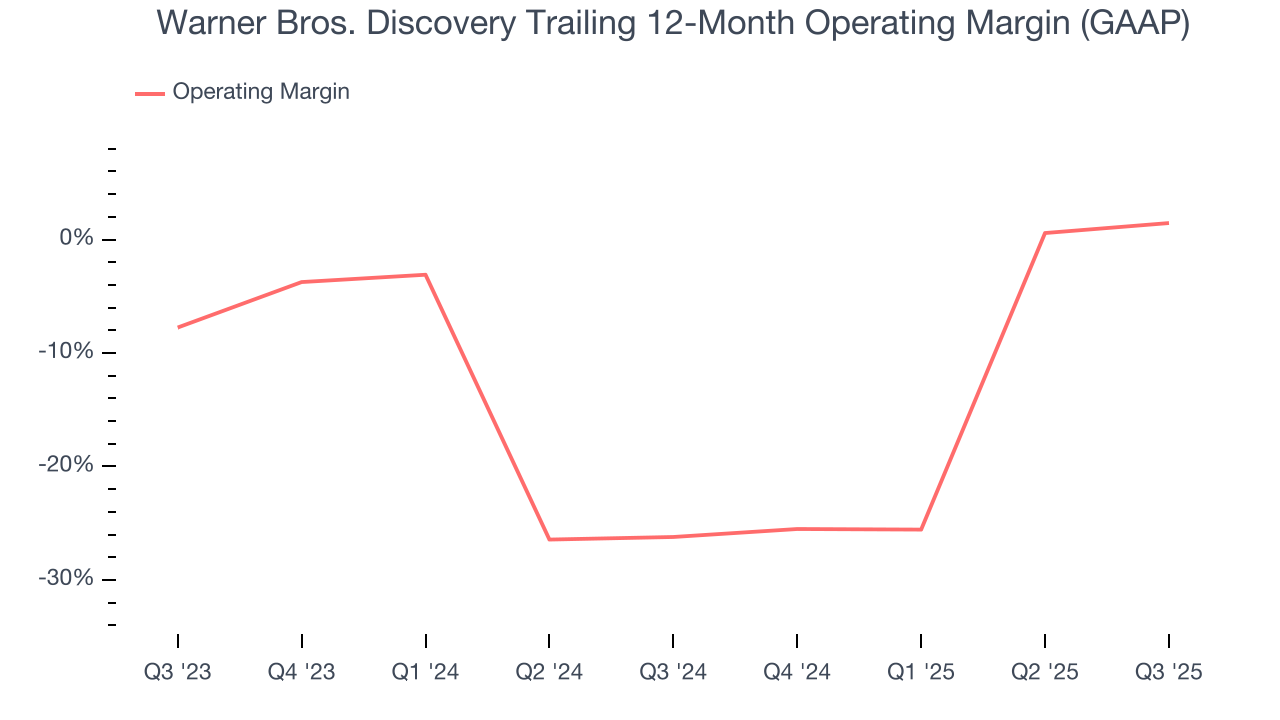
This quarter, Warner Bros. Discovery generated an operating margin profit margin of 6.8%, up 3.8 percentage points year on year. This increase was a welcome development, especially since its revenue fell, showing it was more efficient because it scaled down its expenses.
7. Earnings Per Share
Revenue trends explain a company’s historical growth, but the long-term change in earnings per share (EPS) points to the profitability of that growth – for example, a company could inflate its sales through excessive spending on advertising and promotions.
Sadly for Warner Bros. Discovery, its EPS declined by 38.2% annually over the last five years while its revenue grew by 28.9%. This tells us the company became less profitable on a per-share basis as it expanded.

In Q3, Warner Bros. Discovery reported EPS of negative $0.06, down from $0.05 in the same quarter last year. Despite falling year on year, this print easily cleared analysts’ estimates. Over the next 12 months, Wall Street expects Warner Bros. Discovery to perform poorly. Analysts forecast its full-year EPS of $0.19 will invert to negative negative $0.34.
8. Cash Is King
Free cash flow isn't a prominently featured metric in company financials and earnings releases, but we think it's telling because it accounts for all operating and capital expenses, making it tough to manipulate. Cash is king.
Warner Bros. Discovery has shown decent cash profitability, giving it some flexibility to reinvest or return capital to investors. The company’s free cash flow margin averaged 12.2% over the last two years, slightly better than the broader consumer discretionary sector.
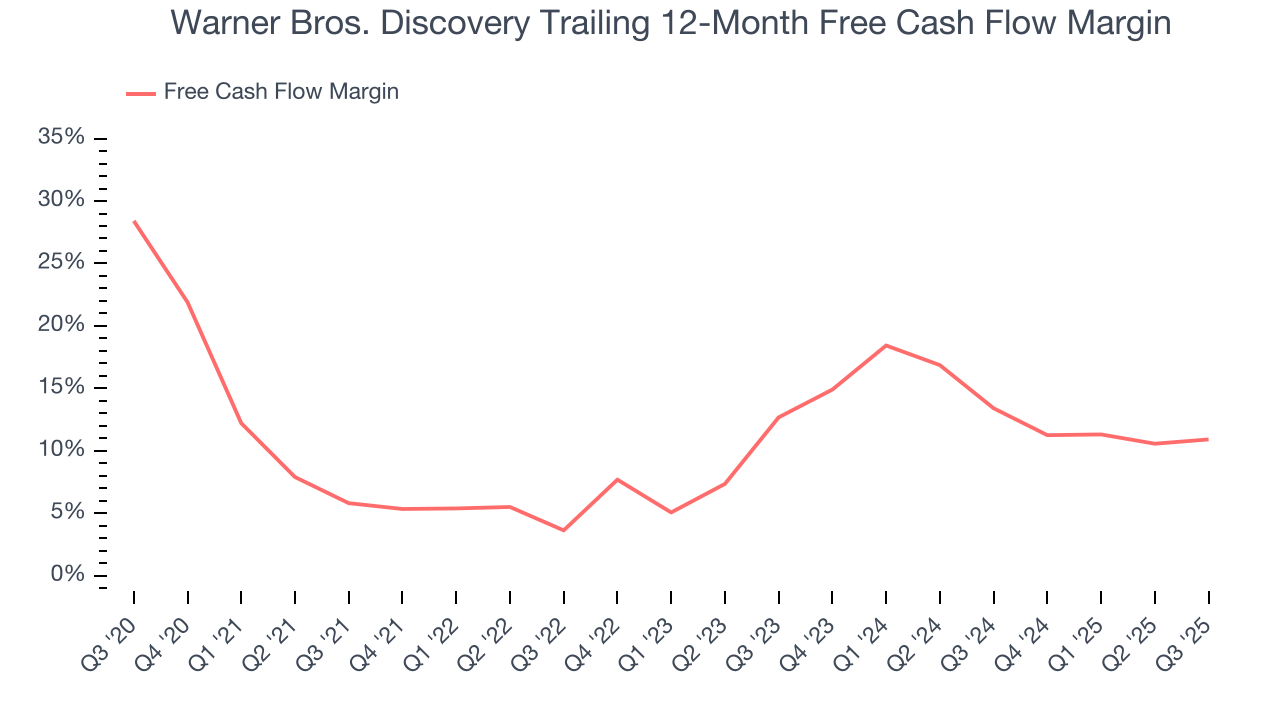
Warner Bros. Discovery’s free cash flow clocked in at $701 million in Q3, equivalent to a 7.8% margin. This result was good as its margin was 1.2 percentage points higher than in the same quarter last year, but we wouldn’t read too much into the short term because investment needs can be seasonal, leading to temporary swings. Long-term trends trump fluctuations.
Over the next year, analysts’ consensus estimates show they’re expecting Warner Bros. Discovery’s free cash flow margin of 10.9% for the last 12 months to remain the same.
9. Return on Invested Capital (ROIC)
EPS and free cash flow tell us whether a company was profitable while growing its revenue. But was it capital-efficient? Enter ROIC, a metric showing how much operating profit a company generates relative to the money it has raised (debt and equity).
Warner Bros. Discovery’s five-year average ROIC was negative 4.9%, meaning management lost money while trying to expand the business. Its returns were among the worst in the consumer discretionary sector.
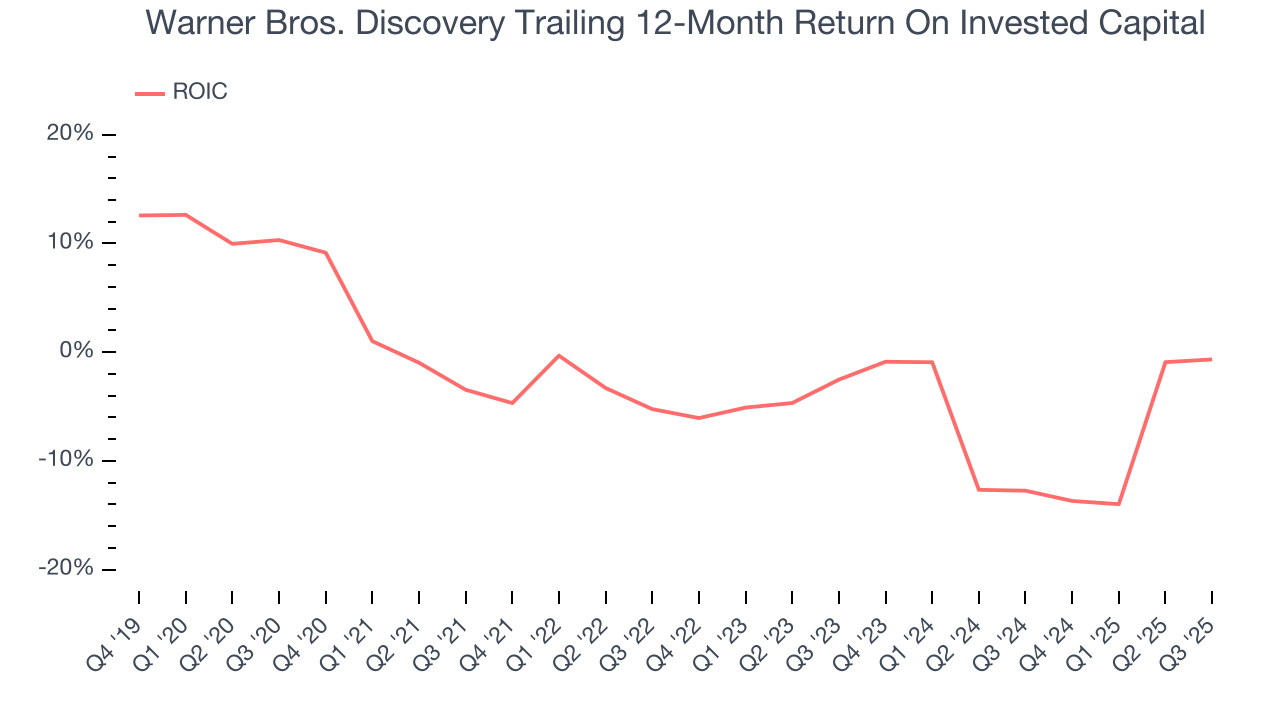
We like to invest in businesses with high returns, but the trend in a company’s ROIC is what often surprises the market and moves the stock price. Unfortunately, Warner Bros. Discovery’s ROIC averaged 2.4 percentage point decreases over the last few years. Paired with its already low returns, these declines suggest its profitable growth opportunities are few and far between.
10. Balance Sheet Assessment
Warner Bros. Discovery reported $4.29 billion of cash and $33.52 billion of debt on its balance sheet in the most recent quarter. As investors in high-quality companies, we primarily focus on two things: 1) that a company’s debt level isn’t too high and 2) that its interest payments are not excessively burdening the business.
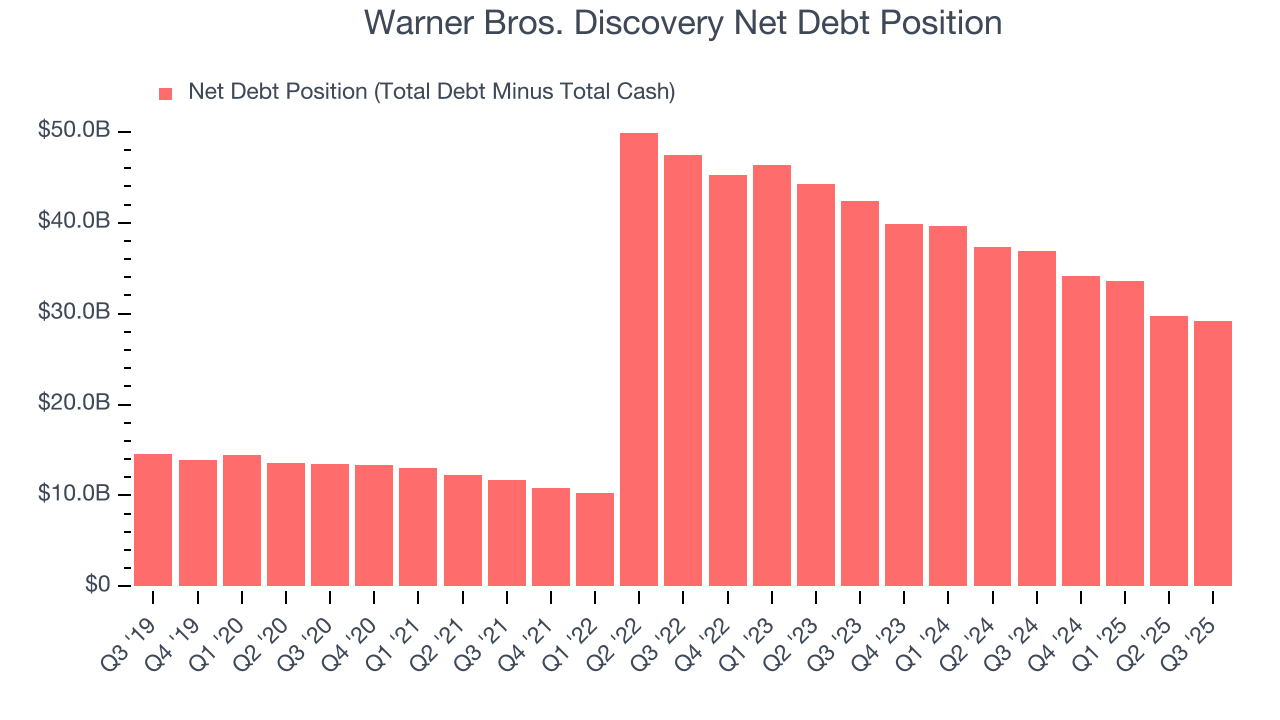
With $9.25 billion of EBITDA over the last 12 months, we view Warner Bros. Discovery’s 3.2× net-debt-to-EBITDA ratio as safe. We also see its $1.84 billion of annual interest expenses as appropriate. The company’s profits give it plenty of breathing room, allowing it to continue investing in growth initiatives.
11. Key Takeaways from Warner Bros. Discovery’s Q3 Results
It was good to see Warner Bros. Discovery beat analysts’ EPS expectations this quarter. We were also glad its EBITDA outperformed Wall Street’s estimates. On the other hand, its Content revenue missed and its Advertising revenue fell short of Wall Street’s estimates. Overall, we think this was a mixed quarter. The stock remained flat at $22.54 immediately after reporting.
12. Is Now The Time To Buy Warner Bros. Discovery?
Updated: December 4, 2025 at 9:06 PM EST
We think that the latest earnings result is only one piece of the bigger puzzle. If you’re deciding whether to own Warner Bros. Discovery, you should also grasp the company’s longer-term business quality and valuation.
Warner Bros. Discovery falls short of our quality standards. First off, its revenue growth was weak over the last five years, and analysts expect its demand to deteriorate over the next 12 months. On top of that, Warner Bros. Discovery’s Forecasted free cash flow margin for next year suggests the company will fail to improve its cash conversion, and its declining EPS over the last five years makes it a less attractive asset to the public markets.
Warner Bros. Discovery’s EV-to-EBITDA ratio based on the next 12 months is 7x. While this valuation is optically cheap, the potential downside is huge given its shaky fundamentals. There are better investments elsewhere.
Wall Street analysts have a consensus one-year price target of $22.47 on the company (compared to the current share price of $24.61).







